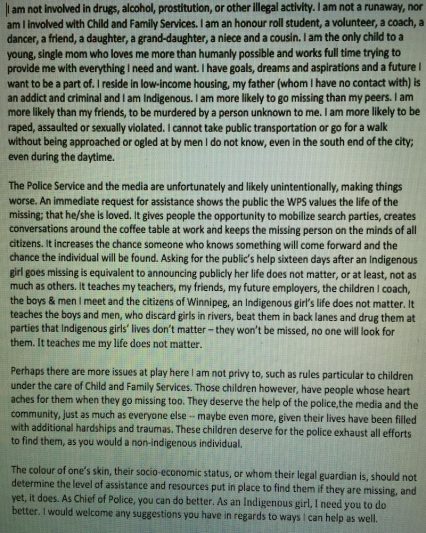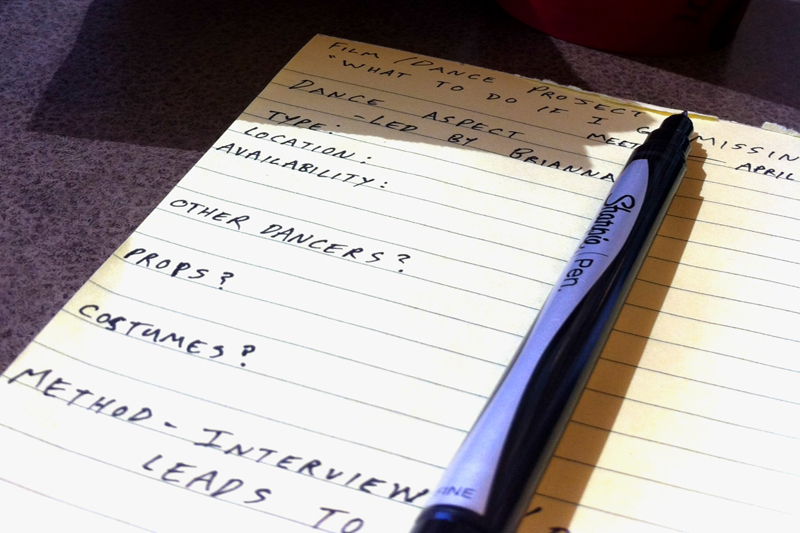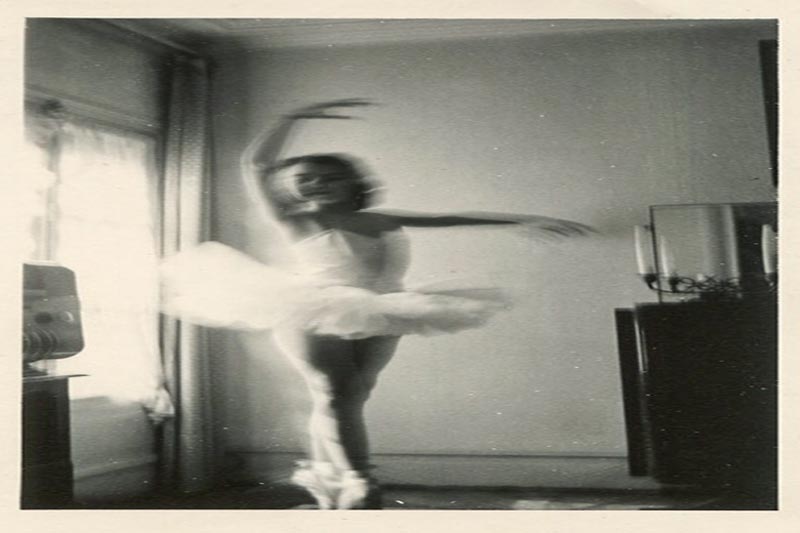I sit and wait in a coffee shop. My notepad
perfectly prepared for a meeting that I’ve
arranged.
A meeting to discuss a film project with a girl
who is fourteen, and her mother.
They arrive, and we all shake hands. I invite
them to my table.
So far, we have been discussing, over email and
Facebook, something we all feel is quite important.
Here in my city, where the rates of murder and
reported domestic abuse are among the highest
in the country, kids go missing. Girls, especially.
And mixed up with that issue, is ethnicity. In
general, to my knowledge, no race of children
goes missing by design more than any other,
unless of course you factor in systemic
race-related economic and cultural issues.
But this girl who’s sitting here with me has
noticed something. A disturbing trend. A
highly-visible disregard for Indigenous
Peoples.
She is dismayed that the general public does not
seem to care as much when kids who are Indigenous
go missing. They don’t mobilize like they do
for non-Indigenous kids. When the public does
mobilize to look for an Indigenous kid, it’s not
on the day that the kid goes missing. It’s not
even that week. It’s more than two weeks, or
even months later. “Why is that?”, she wants to
know. What assumptions of blame are being
placed on the Indigenous youth?
It’s not a theory. She points out the
differences in recent cases. I check her
numbers, and they’re solid.
She’s happy that so many care about
non-Indigenous kids. She doesn’t want that to
change. She’s grateful about that. That’s
the way it should be, she asserts, for
everybody.
But why isn’t it? Are we that different?
Brown kids, white kids, purple, green? Is it
truly of less consequence to us as a culture when
a child who is killed was brown? I mean how on
earth is skin color relevant? We all bleed red.
We’re all in this together. She has a point.
“What to do if I go missing,” is the subject of
a letter that she wrote to the police, who met
with her and listened. She wanted them to
examine their process, and ensure that the same
social importance was being placed on
Indigenous and non-Indigenous kids.

She tells me the police took her seriously and
seemed like they wanted to learn from her.
There was another letter too. To Child And
Family Services, under whose care, some
children have gone missing recently. This
service seems to have been less helpful, filling
silent spaces in their awkward meeting with
jokes my new friend didn’t think were funny.
Jokes. She was not prepared for jokes. The
ugly world these people live in has its share
of necessary evils. I don’t blame them for
their callousness. I think about how I might
do the same to trick myself into a place where
I can do a job like that, day in and day out,
seeing broken hearts and broken families.
Maybe they do care but have been desensitized
by witnessing so much horror, and having their
hands bound when it comes to doing anything
meaningful about it. Whatever the reason, she
felt her words were wasted on them.
Maybe it is, in fact, systemic racism. The
evidence exists. Our society at large cares
less about brown kids. There is a measurable
scale of “I give a shit” that seems remarkably
related to skin color. Perhaps the people at
home, when they hear about some missing brown
kid, don’t have the emotional resources to care.

But somebody has to.
I have to. And it hurts to care. It’s awful.
Thinking about the breadth and scope of this
problem.
That’s why I’m in this coffee shop, and meeting
with these two.
She is a dancer, I’m a movie maker, and we want
to make a dance film. Because that is her
passion. And because I want her voice to
be heard far and wide. There’s power in this girl.
She is important. She’s the kind of person who
will not go down without a fight. And that’s
remarkably rare.
We work through my list of production details.
Times available, costumes, props, locations,
music, style of dance …
I sip my coffee, and we keep talking. Quiet and
polite, a gentle smile, she holds herself with
dignity, as we discuss the topic of the dance:
that she, an Indigenous girl, should matter just
as much as anybody else does. It’s simple
really. But in our culture, it is not a given.
She’s not looking for special treatment, just
balance. Equality.
Over her shoulder, and behind a glass divider,
a young man, somewhere between 16 and 20, tall,
goofy smile, white, taps on the glass directly
behind her. I’m thinking that she knows this
guy. Maybe some friend from school.
He’s pressing himself lewdly against the glass.
He mimics cunnilingus using his tongue and
fingers. His other hand moves to grope his own
genitalia. All while he keeps tapping on the
glass, trying to get her attention. She stops
talking, stares straight ahead, specifically
ignoring him. “Do you know this person?”, I
ask. She does not. “This happens all the
time,” her mother says with frustrated disgust.
I catch the boy’s eyes, shaking my head “no”
sternly, like a father would. I mouth the words
“get the fuck out!” and angrily staring him
down, indicate the door. He complies, and
leaves the coffee shop.
I don’t think that my guests expected me to
react. People seldom do react in these types
of situations. We all seem generally more
inclined to self-preservation, or whatnot.
But I’m a torture victim and a martial artist.
I don’t scare easy. And I’m rarely polite to
people who themselves are not polite. Kindness
is not suitable for every situation. I find
forbearance in the face of such behavior to be
an abuse enabler. Therefore, I do not turn the
other cheek very often.
I take a moment to calm down and ask my guests
to please forgive my behavior. I got angry,
which I know from my training to be unhelpful
in potentially volatile situations. But I was
upset as if this were MY daughter. While
grounding, it hits me, the reality. This
happens all the time. It’s normal for her.
And for many girls just like her.
Normal to them, to be assaulted this way.
It’s no wonder that she thinks often about the
disturbing possibility of being sexually
assaulted, abducted, or even killed.
For her, this is a real concern. People intrude
upon her space. They try to intimidate her.
She lives under threat. It isn’t just some
social issue to her. It’s an urgent and ongoing
need for self-preservation. Her letter, “what
to do if I go missing”, includes a recent photo
of her. It is a serious attempt to give the
police what they need in order to quickly find
her if she does indeed go missing. Or at least,
she hopes it will help them to discover the
importance of promptly looking for her.
She seems embarrassed by what just happened to
her in the coffee shop. Her spark has
momentarily left her, and she has shrunken a
little into her seat.
“Are you okay?” I ask her. She nods yes.
I see strength in her mother’s eyes. The kind
that comes from years of worry and
determination. She comforts her girl, shows
her love. And I can see the brightness
returning. Quite quickly, she seems once again
empowered. Now that the rude boy has left the
building, and her mom has admirably controlled
the damage.
My dancer has questions she wants our film to
ask. She presents them eloquently:
“What does this indifference say to young
Indigenous girls about their value?”
“What does it say to predators about who they
can get away with harming?”
“How can we become equal?”
And I do not have the answers.
“I can help you ask these questions,” I tell her.
“Sometimes art can do far more to reach hearts
than words can. You lead this dance. The
whole thing. And I will film it. And together
we can bring this message to as many people as
possible. Because you DO matter.”
She is excited about using her passion and power
to convey her message of equality.
When the meeting’s over, I feel purposeful. I
walk home with my head held high, and my mind
swimming. Who will fund this? How can I pay
rent while I make this? I HAVE to make this.
I sit here on a Tuesday morning hoping.
Not for my success so much. Well that too, but
for this young dancer to be able to move people.
Because so far, words have not.
I beg and plead with the universe, the spirit
of humanity, deities, benevolent rich people,
anything or anybody listening …
Please.
Help me bring this girl’s voice to the world.
Help me film her dancing like she matters.
Because she DOES matter. She is every single
one of us.
And we are her.
We can’t ignore this.
Photo Credit: oakenroad via Compfight cc

It makes my heart hurt that anyone would be treated this way – as though they didn’t matter, or weren’t worthy of respect, because of ANYTHING, but it seems especially stupid that their ethnic background should be the reason. It pisses me off no end that people are so willing to buy into ignorance and prejudice and objectification, without ever thinking about their impact on the living, breathing, feeling PERSON on the receiving end of their dumbassery.
GOOD FOR YOU for trying to make this project happen, and for being an advocate for people so used to being marginalised.
From years of looking at court dockets in Canada, it’s a sad state of affairs even with reported cases. One of the worst recurring “solutions” I’ve seen is sentencing an offender to -house arrest- in the home where his/her victims also continue to reside. But here too, I’ve spoken with many people on the ground who tell me girls as young as 9 years old are being abducted and put to work by pimps right here in the city.
People often blame foreigners for creating this market, but the true stats have American and Canadian citizens at the top of the list of people who pay money to abuse these children. If I can raise money with this project, what I don’t use on bills and development will be donated to a group called O.U.R., which my dancer has agreed is a worthy related charity. http://ourrescue.org/
Thank you Donna. I’m a slow and encumbered activist, I’m afraid. But better than nothing, right? 🙂
Incredible, powerful piece. Blown away by the excerpt written by the young woman you interviewed. She’s brilliant. All lives matter. All women’s lives matter. Criminal that both Canadian and US do not put same efforts into protecting everyone (regardless of gender and ethnicity) from predators and finding all murdered, missing and abused women and children, regardless of ethnicity.
EXCELLENT ARTICLE!! THANK GOD SOMEONE IS NOT ONLY LISTENING BUT ALSO ‘ACTING’…
Thank you so much Dori. When I was very young, I lived in Phoenix. I’m a Metis mix of a bunch of different races including and not limited to N. American Indian and Inuit (some say Eskimo), but I pass for “white”. I do a lot of work involving giving a voice to people less considered due to their race, and I’m totally an “undercover Aboriginal”, so that book actually sounds like something I’d relate to. And I love YA too. Probably my favorite target market to read. Truly, if you know anybody willing to contribute to a film effort, I’d love to meet with them.
Beautiful and poignant, Byron. I live in Arizona, home to 19 different tribes. They are not part of the (conservative, white) mainstream and rarely have a voice in decisions that impact them. Make that movie! P.S. Do you read Sherman Alexie? If you haven’t read it, I would highly recommend his “The Absolutely True Diary of a Part-Time Indian. It’s YA, but one of my favorites. In the meantime, I’ll be on the lookout for wealthy film investors….. D.